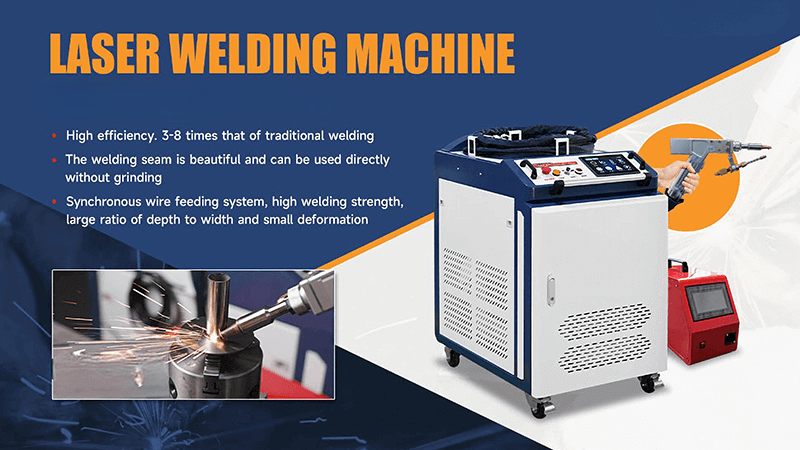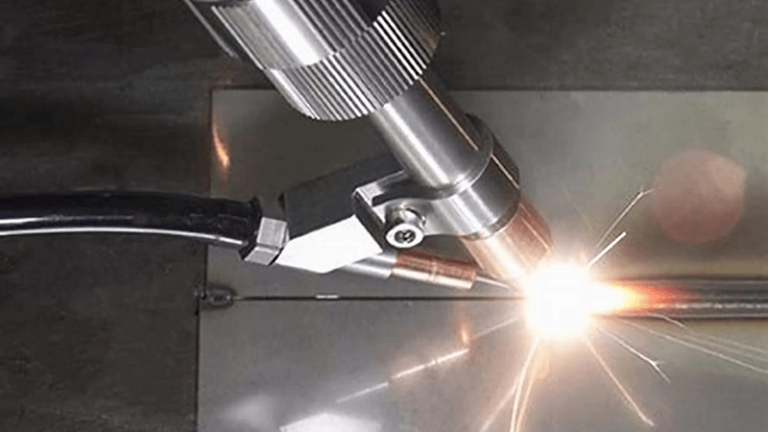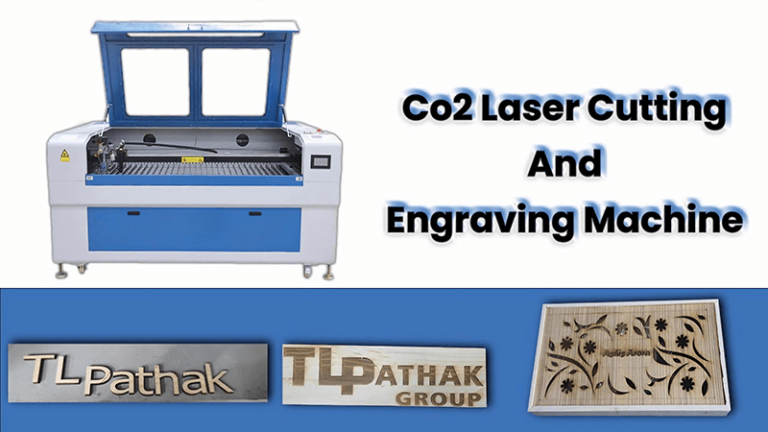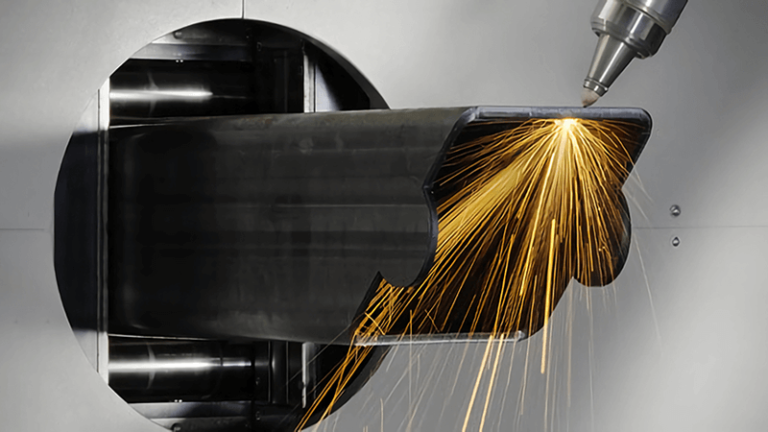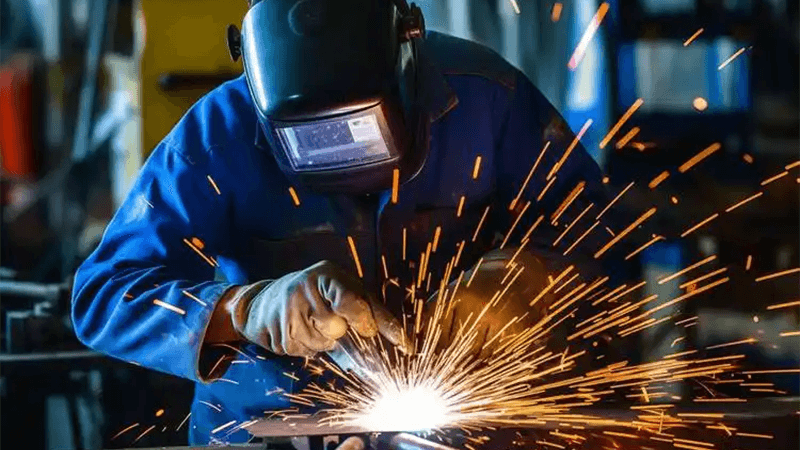
When it comes to welding, precision is the name of the game. If you’ve ever dealt with delicate materials, tiny parts, or intricate designs, you know how difficult it can be to achieve perfection. That’s where fiber welding comes into play. The ability to manipulate heat and energy with laser-like precision has revolutionized industries from automotive to aerospace.
Fiber welding offers numerous benefits that make it an excellent choice for precision work across various industries. Its high accuracy, minimal heat impact, speed, versatility with materials, reduced need for post-processing, cost-effectiveness, and ease of automation position it as a leading technology in modern manufacturing processes.
But what exactly makes fiber welders stand out when it comes to precision work? Let’s dive into the top benefits.
Unmatched Precision and Accuracy
One of the first things that sets fiber welders apart is their ability to deliver exceptional precision. Unlike traditional welding methods, which can sometimes result in uneven heat distribution, fiber welders focus the energy into a concentrated beam. This results in cleaner, more accurate welds, even on the smallest components. With a fiber welder, I can confidently handle intricate parts with minimal distortion.
Think about it: when you're working with delicate materials like thin metals or sensitive alloys, a slight deviation in the welding process can lead to disastrous results. Whether you're working on tiny connectors or complex, multi-part assemblies, fiber welders provide the reliability needed to ensure a perfect finish every time.
Fiber welders offer unmatched precision and accuracy compared to traditional welding methods.True
Fiber welders focus energy into a concentrated beam, resulting in cleaner and more accurate welds, even on the smallest components.
Fiber welding significantly increases the size of the heat-affected zone (HAZ), leading to more material distortion.False
Fiber welding actually reduces the size of the heat-affected zone, minimizing material distortion and preserving the integrity of the surrounding material.
What Are the Advantages of Fiber Laser Welding Machines in Achieving High Welding Precision?
-
Achieving Welding of Small Components
- High Positioning Accuracy: The laser beam has an exceptionally small focal diameter, enabling extremely precise positioning.
- Application Example: In the microelectronics industry, handheld fiber laser welding machines are used to weld tiny chips and precision electronic components in devices such as smartphones and computers. This ensures accurate connections between small parts, maintaining the high performance and stability of the products.
-
High Weld Quality
- Weld Characteristics: Produces narrow, deep, and uniformly consistent weld seams with a minimal heat-affected zone.
- Enhanced Strength: Weld strength is typically higher than that achieved with traditional welding methods, effectively reducing thermal deformation and stress.
- Application Example: In the manufacturing of precision instruments, such as engine blades in the aerospace sector and precision components in medical devices, handheld fiber laser welding machines deliver high-quality welds without compromising the performance of surrounding materials. This ensures strict dimensional accuracy and superior mechanical properties of the welded parts.
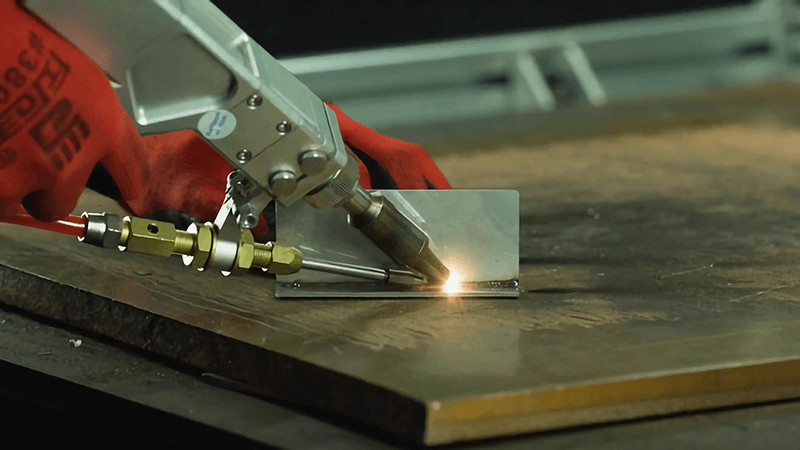
-
Precise Welding of Complex Shapes
- Welding Flexibility: Capable of welding various complex-shaped workpieces, reaching areas that traditional welding equipment cannot access.
- Versatile Welding Techniques: Supports multiple welding methods, including overlapping welding, butt welding, vertical welding, flat angle welding, internal angle welding, and external angle welding.
- Application Example: In automotive manufacturing, these machines are used to weld car body panels, interior components, and parts with intricate curves and shapes. This precise welding capability enhances the overall quality and safety of vehicles by ensuring robust and accurate joins in complex assemblies.
-
Strong Material Adaptability
- Wide Range of Materials: Capable of welding various metals, including stainless steel, carbon steel, aluminum alloy, and copper.
- Special Material Welding: Effectively welds difficult-to-weld materials such as titanium alloys and nickel-based alloys while maintaining high precision.
- Application Example: In jewelry manufacturing, handheld fiber laser welding machines are used to join metal parts of different materials seamlessly. This ensures high-precision connections without damaging the intrinsic properties of the materials, allowing for the creation of intricate and durable jewelry pieces.
Speed and Efficiency in Precision Work
Another key benefit of fiber welders is their speed. While precision is critical, so is time. Fiber lasers can work quickly, minimizing heat exposure to the surrounding material, which is crucial in reducing distortion. The faster the weld, the less heat there is to affect the material, and the cleaner the result.
In my own experience, this speed doesn’t come at the expense of quality. The fiber laser is able to cut through metals with minimal heat-affected zones, preserving the material's integrity. Not only does this save time, but it also reduces the need for additional post-weld work, which in turn lowers production costs.
Precision in Thin Materials
I’ve worked with many materials in my career, and one of the toughest challenges is welding thin or delicate components. Traditional methods can struggle with heat control on thin materials, leading to burn-through or distortion. With fiber lasers, the ability to fine-tune the energy levels means that even the thinnest materials can be welded without risk of damage.
The narrow, focused beam of a fiber welder allows for precise control over how much energy is applied, preventing the heat from spreading. This is particularly important in industries like electronics and medical device manufacturing, where precision isn’t just important—it’s essential.

Reduced Risk of Warping
As a Sales Engineer at Kirin Laser, I can’t stress enough how important it is to avoid material warping in precision welding. Traditional methods often struggle with this, especially when you’re working with high-temperature metals. When heat is not evenly distributed, the material can expand and contract, causing it to warp.
Fiber lasers, however, mitigate this issue thanks to their precision beam and ability to control the amount of energy applied. Because the heat is concentrated in a specific area, there’s minimal heat transfer to the rest of the material. This means that the risk of warping is significantly reduced. For me, it’s a game-changer when it comes to delivering consistent, high-quality results.
Fiber laser welding machines are limited to welding only stainless steel and aluminum.False
Fiber laser welding machines are highly versatile and can weld a wide range of materials, including carbon steel, titanium alloys, copper, and even precious metals like gold and silver.
Fiber welders are not suitable for welding thin or delicate materials due to excessive heat application.False
Fiber welders excel in welding thin or delicate materials because they allow precise control over energy levels, preventing burn-through and distortion.
Lower Operating Costs
While fiber lasers may have a higher initial investment, their efficiency leads to significant cost savings in the long run. Not only do they reduce the need for additional processing or post-welding steps, but their energy efficiency makes them cheaper to operate compared to traditional methods.
When I analyze the cost per unit for fiber laser welding versus older techniques, it’s clear that the savings pile up quickly. Since fiber lasers require less maintenance, and their uptime is much higher, I see a faster return on investment. Plus, their long lifespan ensures that businesses aren’t repeatedly shelling out for replacements or repairs.
Versatility in Materials
Fiber welders aren’t limited to just one type of material. Over the years, I’ve seen how fiber lasers can seamlessly handle a wide range of materials, including stainless steel, aluminum, titanium, and even precious metals like gold and silver. This versatility means that manufacturers can use the same equipment across various applications, from automotive parts to jewelry.
What’s great about fiber lasers is that they can be adapted to different materials with ease. The settings can be fine-tuned to match the specific requirements of each material, which increases flexibility in production. For me, this adaptability is one of the best aspects of fiber welding—it’s not just about one product or industry; it’s about catering to many.
Does a Handheld Fiber Laser Welding Machine Excel in Material Consistency?
Handheld fiber laser welding machines demonstrate exceptional performance in maintaining material consistency during the welding process. This excellence is evident in several key areas:
-
Physical Performance Consistency
- Stable Microstructure: The concentrated energy of laser welding results in a small heat-affected zone, minimizing changes to the material's microstructure. For instance, when welding stainless steel, the hardness and toughness around the weld area closely match those of the base material, preventing significant softening or hardening. This ensures the overall physical properties of the material remain consistent.
- Preserved Aluminum Alloy Properties: When welding aluminum alloys, handheld fiber laser machines avoid the substantial loss of alloying elements typically caused by high temperatures in traditional welding methods. This preservation maintains the strength and corrosion resistance of the welded aluminum, which is crucial for manufacturing components in aerospace and automotive industries.
-
Chemical Composition Consistency
- Clean Welding Process: Laser welding is relatively "clean," avoiding the introduction of impurities common in some traditional welding methods. For example, when welding titanium alloys, there are no additional chemical elements introduced from welding rods or wires. This ensures that the chemical composition of the welded area remains consistent with the base material, preserving the corrosion resistance and biocompatibility of titanium alloys—essential for medical implants and chemical equipment manufacturing.
-
Stable Multi-Metal Welding: When welding different metal combinations, such as copper and aluminum, handheld fiber laser machines minimize the mutual diffusion of distinct metals. This retention of each material's characteristics ensures that the welded materials closely resemble the base materials in chemical composition.
-
Appearance Consistency
-
Smooth and Natural Welds: Welds created by handheld fiber laser machines are smooth and flat, seamlessly blending with the base material's appearance. For example, when welding stainless steel kitchenware, the welds are nearly as shiny and uniformly colored as the surrounding stainless steel, maintaining a high level of visual consistency and reducing the need for additional surface finishing processes.
-
Aesthetic and Harmonious Vehicle Bodies: In welding automotive body panels, the weld seams exhibit excellent flatness and color matching with adjacent panels. This results in a more attractive and harmonious overall appearance of the vehicle body, enhancing product quality and market competitiveness.
-
The speed of fiber welding compromises the quality of the welds, requiring extensive post-processing.False
Fiber welding combines high speed with high quality, reducing the need for additional post-processing by producing clean and precise welds quickly.
Fiber welding machines are generally more expensive to operate in the long run compared to traditional welding methods.False
Fiber welding machines are cost-effective over time due to their energy efficiency, reduced maintenance needs, and lower operating costs, leading to significant long-term savings.
Reduced Heat Affected Zones (HAZ)
Another benefit of fiber welding is the reduced size of the Heat-Affected Zone (HAZ). In traditional welding, the heat can spread far beyond the intended area, causing undesirable changes in the material’s properties, such as reduced strength or corrosion resistance. With fiber lasers, the beam is so focused and precise that the HAZ is kept to a minimum, ensuring the surrounding material stays intact.
This is particularly important when welding materials that are sensitive to heat, like high-performance alloys or heat-treated metals. The precision of the fiber welder makes sure the material maintains its strength and properties, without compromising the weld’s integrity.
Minimal Post-Welding Finishing
The level of detail that fiber welders provide means there’s often little to no need for post-welding finishing. In traditional welding, you might find yourself spending hours sanding, grinding, or polishing to smooth out weld seams and remove imperfections. But with a fiber laser welder, the welds are often so clean that you can skip these steps altogether, saving valuable time and resources.
In fact, I’ve seen some projects where the welds were so precise that the only post-weld work required was a quick visual inspection. For any business, this translates to reduced labor costs and faster production times. This clean, precise process is one of the reasons fiber welding is becoming the preferred method in precision-based industries.
Increased Safety for Operators
Fiber welders are inherently safer than traditional welding methods. The laser beam is highly focused, which reduces the risk of sparks, splattering molten metal, and other hazardous byproducts that are common with traditional welding methods. Additionally, fiber laser systems often come with advanced safety features such as enclosed workspaces and automated shielding.
As someone who works with laser welding on a daily basis, I can say that the reduced risk of injury and the clean nature of fiber laser systems makes them ideal for environments where operator safety is a top priority.

Here’s a detailed look at how fiber laser systems enhance safety.
-
Reduced Risk of Hazards
- Minimized Sparks and Splatter: Unlike traditional welding, which often produces sparks and molten metal splatter, fiber laser welding utilizes a highly focused laser beam. This minimizes the risk of fire hazards and injuries associated with flying debris.
- Lower Heat Input: Fiber lasers operate with a low heat input, which reduces the heat-affected zone (HAZ). This precision prevents material distortion and lowers the risk of burns or other heat-related injuries to operators.
- Clean Process: The absence of filler materials and the reduced emission of harmful fumes make fiber laser welding a cleaner process. This not only benefits the environment but also reduces respiratory hazards for operators.
-
Advanced Safety Features
- Enclosed Workspaces: Many fiber laser systems are designed with fully enclosed workspaces that prevent accidental exposure to the laser beam. Access panels are equipped with interlocks that automatically shut off the laser if opened, enhancing operator safety.
- Automated Shielding: Automated safety features can include sensors that detect incorrect beam outputs or reflections, ensuring that the machine cannot operate under unsafe conditions. This proactive approach significantly reduces the risk of accidents.
- Specialized Protective Gear: Operators are provided with advanced protective equipment, such as full-face helmets specifically rated for fiber laser wavelengths. This gear offers superior protection against potential eye damage from the invisible near-infrared beams emitted by fiber lasers.
-
Efficiency and Automation
- Automation Capabilities: The ability to automate many processes in fiber laser welding reduces human exposure to potential hazards. Automated systems can perform repetitive tasks without operator intervention, minimizing risk further.
- High Precision and Control: The focused nature of the laser allows for precise control over the welding process, which not only improves weld quality but also reduces the likelihood of operator error that could lead to accidents.
Conclusion
In my experience, fiber welders are a game-changer when it comes to precision work. They offer unmatched accuracy, speed, and efficiency, making them ideal for industries that require top-notch results. The reduced heat-affected zones, lower operating costs, and versatility in materials are just the cherries on top. If you’re looking to take your welding game to the next level, investing in a fiber welder might be the best decision you’ll ever make.
At Kirin Laser, we’re committed to providing the best in laser welding technology, ensuring you can achieve the precision you need without compromising on speed or cost. So, are you ready to take your welding to the next level?
For more info, don’t hesitate to reach out to us at Kirin Laser. Let’s weld with precision!
References:
- "How Welders with Laser Are Changing the Industry?", from Kirin Laser.
- "Understanding Laser Welding Prices: What to Expect", from Kirin Laser.
- "Laser Welded vs Traditional Welding: Pros and Cons", from Kirin Laser.
- "Top 10 Fiber Laser Welding Machines in 2025", from Kirin Laser.
- "The Future of Welding: Why You Need a Welder with Laser?", from Kirin Laser.
- "The Best Tools for Welding Aluminum to Aluminum: Fiber Laser Welding", from Kirinn Laser.
- "WHAT MAKES LASER WELDING SO ATTRACTIVE?", from Lasermatch.
- "Risks and Safety in Fiber Laser Manufacturing", from Manufacturing-Today.

